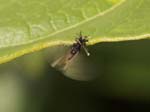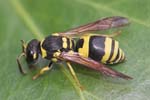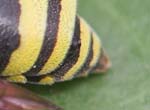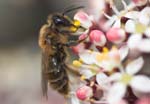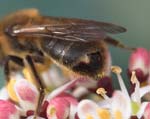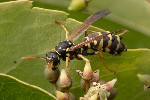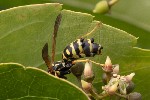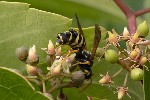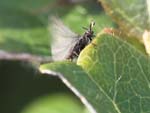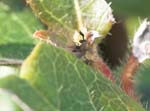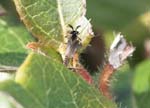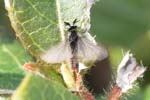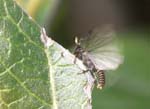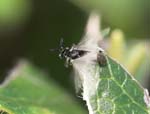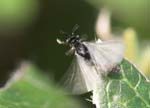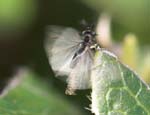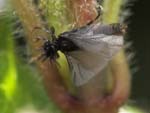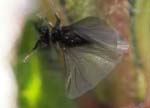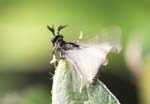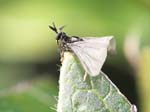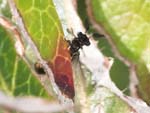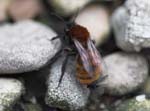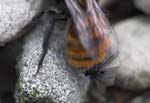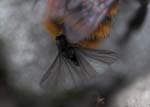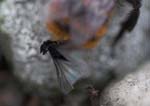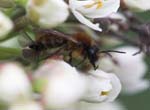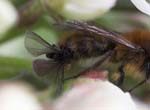

Strepsiptera Stylopidae
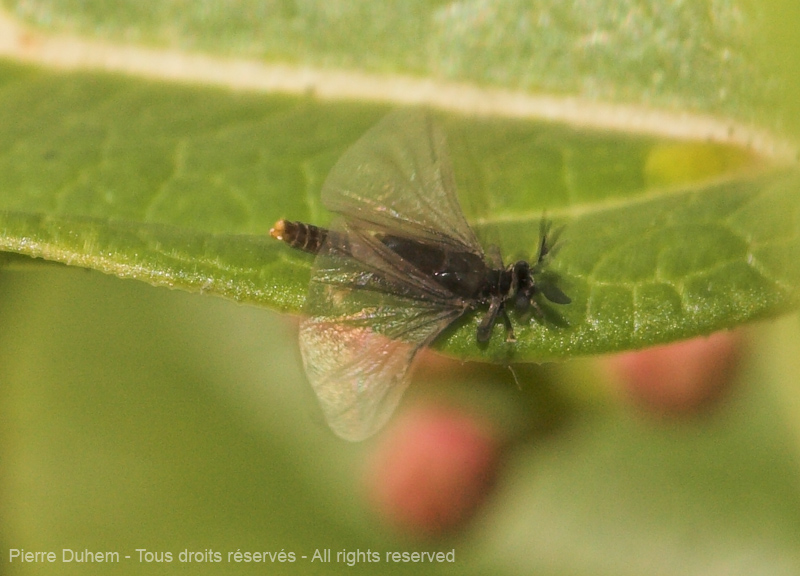
Strepsiptera are a little known order which is nevertheless often mentionned
in the literature. As a matter of fact, those insects only have two wings but,
against Diptera, they have hind wings and fore halters.
Wait for more...
Wait for more...
Click below on the thumbnails to display a bigger picture.
Click again on the picture to come back here.
Click again on the picture to come back here.
All families and genera of this order have a parasitic mode of life, which makes
them already a little apart. More, like other insects, e.g. Psychidae (Lepidoptera, see for instance
this first picture and
this second one
on this web site), there is a strong sexual dimorphism, since the female lives
totally inside the host and never comes out (but some species in the Mengenillidae
family). As for Psychidae, the males are the only form of autonomous imago one
can see. Male Strepsiptera are still more particular because
they have a non-functional mouth and don't feed during their rather short life.
Their only raison d'être is to find a female to copulate and assure the
reproduction. Females get therefore fecondated in situ. The reproduction
is viviparous (no eggs are laid outside of the body of the female). The 1st instar larva are named planidium.
The Stylopidae is the Strepsiptera family which parasits Hymenoptera, and is probably the best known of all Strepsiptera. This explains why one often says that a bee is stylopized.
The Stylopidae is the Strepsiptera family which parasits Hymenoptera, and is probably the best known of all Strepsiptera. This explains why one often says that a bee is stylopized.
The picture above and the next one were taken mid-march 2005, in Montmartre
cemetery. At the time, I didn't know this order and both pictures were taken
almost reflexively...
It is more frequent to see stylopized Hymenoptera, with the caracteristical
anomaly of the abdominal segments because of the presence of the female, like
for this Ancistrocerus auctus.
One can see the cephalothorax of the female pointing between tergits (Xenidae, maybe
Pseudoxenos heydenii).
Some genera seem to be more parasited than other, like Andrena, which must be
related to the nest building habits of hosts and the host searching modus of
parasitic larvae.
For instance, this Andrena sp. bears two parasits under the same tergit.
On the previous picture, which is the same individual, they are rather difficult to see.
Below, this male Polistes sp. bears four or five parasits under three tergits.
It moved only with difficulties.
It was often said that stylopized bees emerge earlier than other.
This could be bound to the fact that the parasit feeds partly on the fat of the host,
which must begin to feed on flowers earlier.
Another noteworthy phenomenon is the so-called parasitic castration, that is the fact that a stylopized female can look like a male because the sexual organs could not develop fully because of the presence of the parasit.
Another noteworthy phenomenon is the so-called parasitic castration, that is the fact that a stylopized female can look like a male because the sexual organs could not develop fully because of the presence of the parasit.
The female never leaves the host and only shows its cephalothorax
on the outside to produce pheromons to attract the male. The cephalothorax only
has a so-called brood opening, through which it gets fecundated.
The sexual organs of the female get autolyzed in the last larval instar and the development of the next generation happens in the hemocoele, the inner cavity. The eggs latch within the hemocoele and the larvae are expulsed to the outside (1,000 to 750,000). First instar larvae are very small (about 0.1 mm) and actively search for hosts. The first instar larvae (called triungulins by analogy with the Meloidae larvae) are mobile. They are legged and some species bear long terminal setae used to spring up to 1cm.
When they find a host (at larval instar), they pierce the tegument using enzyms and begin their parasitic life in the abdomen of the host.
(Elements found in Grimaldi & Engel, Evolution of the Insects, Cambridge University Press 2005)
The sexual organs of the female get autolyzed in the last larval instar and the development of the next generation happens in the hemocoele, the inner cavity. The eggs latch within the hemocoele and the larvae are expulsed to the outside (1,000 to 750,000). First instar larvae are very small (about 0.1 mm) and actively search for hosts. The first instar larvae (called triungulins by analogy with the Meloidae larvae) are mobile. They are legged and some species bear long terminal setae used to spring up to 1cm.
When they find a host (at larval instar), they pierce the tegument using enzyms and begin their parasitic life in the abdomen of the host.
(Elements found in Grimaldi & Engel, Evolution of the Insects, Cambridge University Press 2005)
After crossing the tegument, the larva moulds a first time and
takes an apod form.
Larvae and females only feed by absorbing nutriments through their cuticule. See for instance the abstract of an article by Jürgen Brandenburg and Franz-Rainer Matuschka published in Parasitology Research.
Larvae and females only feed by absorbing nutriments through their cuticule. See for instance the abstract of an article by Jürgen Brandenburg and Franz-Rainer Matuschka published in Parasitology Research.
I had the luck, this year (2008), to see another male on the same Viburnus tinum stand. Pictures are cropped, which explains the modest quality.
The male Stylopid has a rather uncoordinated flight and moves without rest those curious fan-like hind wings, and also the fore halters.
The fan-like hind wings, with those rudimentary veins, give the insect a somewhat unreal aspect.
I could have thought that my luck as a Strepsiptera hunter was total, but I had more to see... A few days later, I could see a male in copula on the abdomen of an Andrena, probably Andrena fulva.
Two feet further, another Stylopid was seen in copula on another Andrena sp.
The Web offers many resources on Strepsiptera, in particular on the Tree of Life project:
Strepsiptera Page, by Jeyaraney Kathirithamby (Oxford, Great Britain)
Strepsiptera Checklist, with hosts, by the same author
Sub-order Stylopidia Page, by the same author
Page on relations between Stylopidia and Hosts, again by the same author
Page of Jeyaraney Kathirithamby on the Web site of Oxford University
World Strepsiptera Database, with some bibliography
Article from Journal of Experimental Biology about the eyes of this family, which are not quite like others, as you can guess...
Strepsiptera Page, by Jeyaraney Kathirithamby (Oxford, Great Britain)
Strepsiptera Checklist, with hosts, by the same author
Sub-order Stylopidia Page, by the same author
Page on relations between Stylopidia and Hosts, again by the same author
Page of Jeyaraney Kathirithamby on the Web site of Oxford University
World Strepsiptera Database, with some bibliography
Article from Journal of Experimental Biology about the eyes of this family, which are not quite like others, as you can guess...
Other Picture Sites (accessible on the Net)
Fine topic on the forum Monde des insectes with a Polistes dominulus carrying at least 5-6 Xenos vesparum male.
Fine topic on the forum Monde des insectes with a Polistes dominulus carrying at least 5-6 Xenos vesparum male.
Bibliography (accessible on the Net)
Cryptic diversity and female host specificity in a parasitoid where the sexes utilize hosts from separate orders, where you'll learn that male and female parasits target hosts of different orders.
On Stylops and Stylopisation (1914), by G. SMITH and A. H. HAMM, interesting about the concept of parasitary castration.
The effects of parasitic and other kinds of castration in insects, by William Morton Wheeler (Journal of Experimental Zoology, vol. VIII, no 4, July, 1910).
Crazy wasps - when parasites manipulates the Polistes phenotype by Laura Beani (Ann. Zool. Fennici 43:564-574 - 2006).
Cryptic diversity and female host specificity in a parasitoid where the sexes utilize hosts from separate orders, where you'll learn that male and female parasits target hosts of different orders.
On Stylops and Stylopisation (1914), by G. SMITH and A. H. HAMM, interesting about the concept of parasitary castration.
The effects of parasitic and other kinds of castration in insects, by William Morton Wheeler (Journal of Experimental Zoology, vol. VIII, no 4, July, 1910).
Crazy wasps - when parasites manipulates the Polistes phenotype by Laura Beani (Ann. Zool. Fennici 43:564-574 - 2006).
As a conclusion, I offer you a picture of Polistes dominula,
single Polistes species which gets stylopised in Europe. On can see a male
Strepsiptera (probably Xenos vesparum) about to emerge from the body of the host.
Picture of Anne Sorbes, included here with her kind permission.
single Polistes species which gets stylopised in Europe. On can see a male
Strepsiptera (probably Xenos vesparum) about to emerge from the body of the host.
Picture of Anne Sorbes, included here with her kind permission.
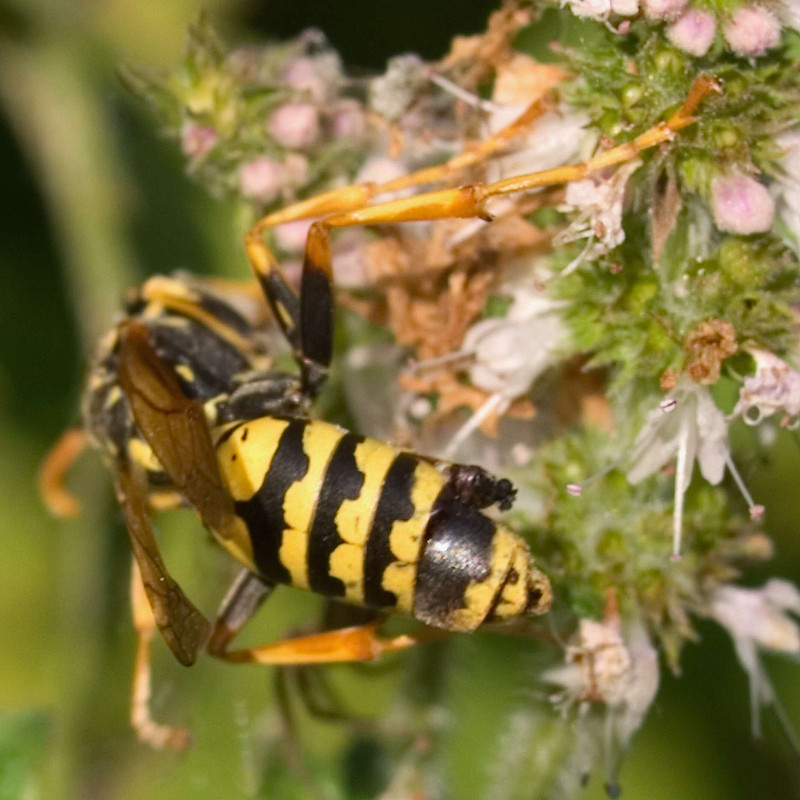
All rights reserved.
Last update: March 2025
Questions and comments are welcome.
Back to the Feature Gallery
Last update: March 2025
Questions and comments are welcome.
Back to the Feature Gallery
